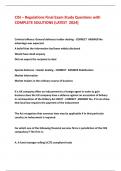Resume
Samenvatting Business Research Methods (gedeelte M. Cools) KULeuven MBA ()
- Établissement
- Katholieke Universiteit Leuven (KU Leuven)
Volledige en duidelijke samenvatting van het vak Business Research Methods (gedeelte gegeven door M. Cools). De samenvatting bevat alle slides uit de les aangevuld met eigen notities. LET OP: de samenvatting is exclusief de lessen gegeven door K. Cleeren
[Montrer plus]












